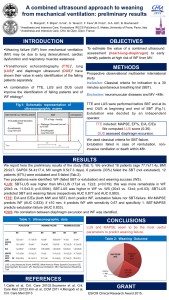Price S, Platz E, Cullen L, Tavazzi G, Christ M, Cowie MR, Maisel AS, Masip J, Miro, McMurray JJ, Peacock WF, Martin-Sanchez FJ, Somma SD, Bueno H, Zeymer U, Mueller C; Acute Heart Failure Study Group of the European Society of Cardiology Acute Cardiovascular Care Association. Abstract Echocardiography is increasingly recommended for the diagnosis and […]

S. Mongodi, F. Mojoli, G. Via, G. Tavazzi, F. Fava, M. Pozzi, G. A. Iotti, B. Bouhemad
Introduction: Weaning failure (WF) from mechanical ventilation (MV) may be due to lung derecruitment, cardiac dysfunction and respiratory muscles weakness. Transthoracic echocardiography (TTE) [1], lung ultrasound (LUS) [2] and diaphragm ultrasound (DUS) [3] have shown their value in early identification of the failing patients separately. A combination of TTE, LUS and DUS could improve the identification of failing patients and of WF etiology [4]. We aimed to estimate the value of a combined ultrasound assessment (heart-lung-diaphragm) to early identify patients at high risk of WF from MV.
Methods: Prospective observational multicenter international study including all patients undergoing a 30’ spontaneous breathing trial (SBT) before extubation. Patients with neuromuscular diseases and MV <48 hours were excluded. TTE and LUS were performed before SBT and at its end; DUS at beginning and end of SBT. TTE included: MAPSE (mitral annulus plane systolic excursion), EF% (ejection fraction), E/A, E/Ea. We computed LUS score (0–36) [2]. DUS assessed diaphragm excursion. Extubation was considered as failed in case of reintubation, non-invasive ventilation or death within 48 hours. We used classical criteria for SBT failure. Extubation was decided by an independent operator.
Results: We enrolled 18 patients (age 77.7 ± 11.4 yrs, BMI 29.9 ± 7, SAPSII 54.4 ± 17.4, MV length 9.5 ± 7.3 days). 6 patients (33%) failed the SBT and were not extubated. 12 patients (67%) were extubated; 5 failed. Two populations were identified: WF (failed SBT or extubation) and weaning success (WS). LUS: SBT-LUS was higher than MVLUS in the whole population (17 ± 4 vs. 12 ± 3; p = 0.019); this was more remarkable in WF (20 ± 3 vs. 11 ± 3; p = 0.0004). SBT-LUS was higher in WF vs. WS (20 ± 3 vs. 13 ± 4; p = 0.03). SBT-LUS predicted SBT and weaning failure (respectively AUC 0,877 and AUC 0,883). TTE: E/A and E/Ea (both MW and SBT) did not predict WF, extubation failure nor SBT-failure. MV-MAPSE predicted WF (AUC 0,833); if < =10 mm it predicted WF with sensitivity 0.67 and specificity 1. SBTMAPSE predicted extubation failure (AUC 0.833). DUS: No correlation between diaphragm excursion and WF was identified.
Conclusions: LUS and MAPSE seem to be the most useful parameters to predict weaning failure.
References 1. Caille et al., Crit Care 2010 2. Soummer et al., Crit Care Med 2012 3. Kim et al., CCM 2011 4. Mongodi et al., Crit Care Med 2013
Grant The research project received the ESICM Clinical Research Award 2015.
Pag. 30 From Critical Care
Tavazzi G, Kontogeorgis A, Guarracino F, Bergsland N, Martinez-Naharro A, Pepper J, Price S. Crit Care Med. 2017 Apr 21. doi: 10.1097/CCM.0000000000002410. Abstract OBJECTIVES: Inadequate cardiac output is associated with a poor outcome following cardiac surgery and is generally modified by the use of positive inotropic agents, volume resuscitation, and pacing. Echocardiography-guided pacemaker optimization […]
Tavazzi G, White M, Price S. Eur Heart J Acute Cardiovasc Care. 2017 Mar 1:2048872617700866. doi: 10.1177/2048872617700866. Abstract We describe a case of a young woman requiring veno-venous extracorporeal support for severe secondary respiratory failure who developed a myocardial ischaemia due to an intermittent obstruction of the right coronary sinus by a fluttering […]
Mongodi S, Orlando A, Tavazzi G, Pozzi M, Maggio G, Braschi A, Iotti GA, Mojoli F. J Cardiothorac Vasc Anesth. 2016 Dec 7. pii: S1053-0770(16)30659-0. doi: 10.1053/j.jvca.2016.12.007. From Pubmed Share this:
Shillcutt SK, Tavazzi G, Shapiro BP, Diaz-Gomez J. J Cardiothorac Vasc Anesth. 2016 Jul 14. doi: 10.1053/j.jvca.2016.06.033. From Pubmed Share this:
Mongodi S, Via G, Riccardi M, Tavazzi G, D’Armini AM, Maurelli M, Braschi A, Mojoli F. J Clin Ultrasound. 2016 Jul 22. doi: 10.1002/jcu.22383. Abstract Patent foramen ovale (PFO) is a frequent congenital anomaly, but massive right-to-left shunt (RTLS) is normally prevented by higher pressures in left heart chambers. However, mechanical ventilation with positive end-expiratory […]
Guido Tavazzi, MD; Gabriele Via, MD; Antonio Braschi, MD; Susanna Price, MD, PhD Chest. 2016;150(1):e9-e11. doi:10.1016/j.chest.2016.02.687 An 82-year-old woman presented to the ED with severe dyspnea and hypertension (200/133/100 mm Hg). Her medical history included chronic obstructive pulmonary disease and a recent admission for heart failure that was treated with furosemide and a calcium channel blocker. Her […]
F. Mojoli, A. Orlando, S. Mongodi, A. Braschi Chest. 2016; 149(5):e137-e139. doi: 10.1016/j.chest.2015.11.033 Full text from CHEST online first Share this:
G. Via, G. Tavazzi and S. Price Intensive Care Medicine 2016, DOI 10.1007/s00134-016-4357-9 From Pubmed Share this:
